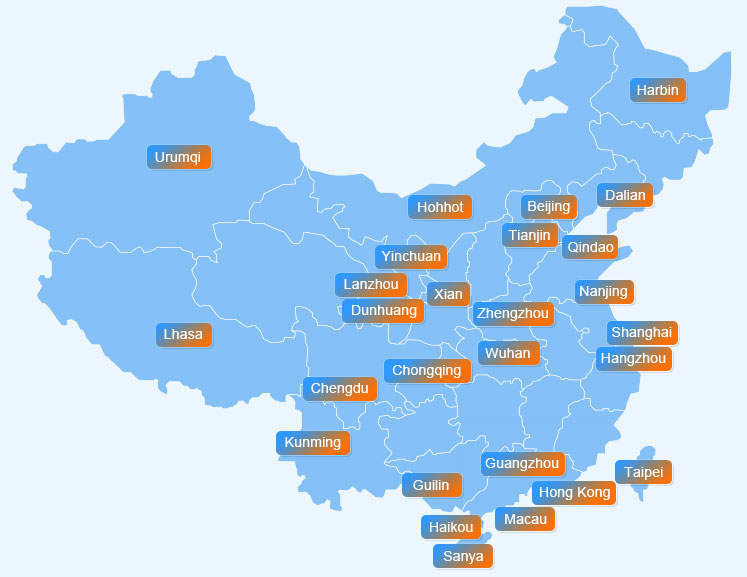China Weather
Tip: Click the city names to see the weather forecast for the coming three days.

- Beijing
- Changsha
- Chengdu
- Chongqing
- Dali
- Dalian
- Dunhuang
- Fuzhou
- Guangzhou
- Guilin
- Guiyang
- Haikou
- Hangzhou
- Harbin
- Hohhot
- Hong Kong
- Huangshan
- Jinan
- Jiuzhaigou
- Kunming
- Lanzhou
- Lhasa
- Lijiang
- Luoyang
- Macau
- Nanchang
- Nanjing
- Nanning
- Ningbo
- Pingyao
- Qingdao
- Qinhuangdao
- Sanya
- Shanghai
- Shenyang
- Shenzhen
- Suzhou
- Taiwan
- Taiyuan
- Tianjin
- Urumqi
- Wuhan
- Wuxi
- Xiamen
- Xi'an
- Xining
- Yangshuo
- Yangzhou
- Yichang
- Yinchuan
- Zhangjiajie
- Zhangjiakou
- Zhengzhou
- Zhuhai
China Weather by Month
Introduction to China Climate
Five Temperature Zones
Precipitation
 |
| China Precipitation Map |
Precipitation in China is basically regular each year. From the spatial angle, the distribution shows that the rainfall is increasing from southeast to northwest, because the eastern seashores are influenced more than inland areas by the summer monsoon. In the place with the most rainfall, Huoshaoliao in Taipei, the average annual precipitation can reach over 6,000mm. The rainy seasons are mainly May to September. In some areas, especially in the dry northwest, changes in precipitation every year are greater than in the coastal area. Based on precipitation, the area divides into four parts: wet area, semi-wet area, semi-dry area and dry area.
Monsoon
With vast territory, China is renowned for its diversity of climates and regions. However, besides the world climate change, the rapid development of economy in the past 30 years resulted in deterioration of air quality. Many cities have been adversely affected by hazy weather since the beginning of 2013, especially those in the central and eastern area.
As a common phenomenon, global warming now is no longer strange to everyone. It is worth to mention that the damage caused by the climate change, from natural disasters to food chain rupture, is involved in all aspects of the human existence.
- Li River, Guilin
- Giant Pandas in Chengdu
- Our Group in Forbidden City
 6-Day Group Package to Beijing/ Xi'an from $1059
6-Day Group Package to Beijing/ Xi'an from $1059
- Last updated on Feb. 20, 2024 by Kina Lu -
Questions & Answers on China Weather
Asked by Table from USA | Feb. 15, 2024 08:49 Reply
Reply
What is the weather like in Longmen Grottoes?
Answers (1)
Answered by Hailey | Feb. 20, 2024 01:18 0
0 0
0 Reply
Reply
Recently, the weather in Longmen Grottoes are rainy and the temperature ranges from -6 -10C.
Asked by Teresa from NEW ZEALAND | Sep. 06, 2023 02:17 Reply
Reply
Will be traveling to guangzhou baiyun qu in September 26 to october 18 will it wind lots
Answers (1)
Answered by Ivy | Sep. 06, 2023 20:31 0
0 0
0 Reply
Reply
It's still too early to predict the weather at that time. But it is not the rainy and windy season, a good time to visit Guangzhou.
Asked by paolo from ITALY | Dec. 27, 2019 12:00 Reply
Reply
Yubeng weather March
Hello, I would like to do the trekking to Yubeng village in late March, do you think is doable in that period of the year? Thank you very much!!
Answers (2)
Answered by Jordyn from GERMANY | Dec. 29, 2019 22:58 0
0 0
0 Reply
Reply
Yes, it will be ok for you to trekking to Yubeng village in late March. Have a nice trip!
Answered by paolo from ITALY | Dec. 30, 2019 04:42 0
0 0
0 Reply
Reply
Thank you very much for your answer!
Asked by Ara from MALAYSIA | Dec. 26, 2019 17:19 Reply
Reply
Yunan lotus garden hostel
Hai
Im at kunming railway station.what is bus no to reach this hotel.thank you.
Yunan lotus garden hostel
1-106 Tea Garden ,West Mountain District,650100 kunming
Im at kunming railway station.what is bus no to reach this hotel.thank you.
Yunan lotus garden hostel
1-106 Tea Garden ,West Mountain District,650100 kunming
Answers (1)
Answered by Isla from DENMARK | Dec. 29, 2019 22:35 0
0 0
0 Reply
Reply
Take subway line 1 to Fude Metro Station. Then take bus no.A9 to Yunnan Folk Village. Then walk south around 400 meters to find the hotel.